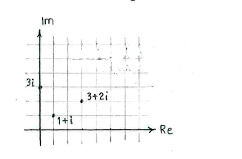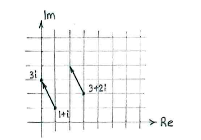Solution 3.2:3
From Förberedande kurs i matematik 2
If we mark the three complex numbers in the plane, we see that the fourth corner will have \displaystyle 3+2i and \displaystyle 3i as neighbouring corners.
In order to find the fourth corner, we use the fact that in a square opposite sides are parallel and all sides have the same length. This means that the vector from \displaystyle 1+i to \displaystyle 3i is equal to the vector from \displaystyle 3+2i to the fourth corner.
If we interpret the complex numbers as vectors, this means that the vector from \displaystyle 1+i to \displaystyle \text{3}i is
| \displaystyle 3i-(1+i) = -1+2i |
and we obtain the fourth corner if we add this vector to the corner \displaystyle 3+2i,
| \displaystyle 3+2i+(-1+2i) = 2+4i\,\textrm{.} |


